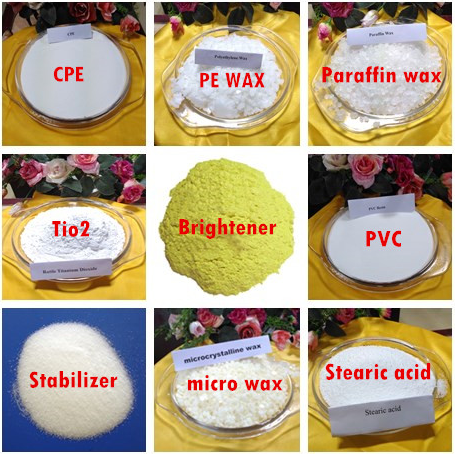1.
Stabilizer The most widely used stabilizers in PVC foam products are lead salt stabilizers and calcium-zinc stabilizers. With the stricter environmental protection requirements and the increasing cost performance of calcium-zinc stabilizers, the application of calcium-zinc stabilizers has begun to change. become more and more widespread.
Insufficient stabilizer, yellowing of the board surface, high brittleness of paste and products, reduced strength and low foaming rate;
If the stabilizer is too much, the foaming agent will decompose in advance, the gas will overflow from the feeding hole and the vacuum hole, and there will be cracks or shrinkage marks in the cavity structure;
2. External lubricant
The most widely used external lubricants on foamed products are generally
Paraffin Wax and
PE WAX. Paraffin wax is easy to precipitate, so PE wax is generally used.
Insufficient external sliding, the temperature of the 4th and 5th zones of the extruder is not easy to control, and it is easy to overheat. Large bubbles, clusters of bubbles, yellowing, and rough surface of the board appear on the board surface; frictional shear heat increases, causing material decomposition, and board surface yellow, paste;
Excessive slippage and poor plasticization lead to scaling in the cavity of the mold and precipitation on the surface of the product, which is prone to leucorrhea, uneven wall thickness and some symptoms that move back and forth on the surface irregularly;
3. Internal lubricant
Commonly used internal lubricants are
Stearic Acid, 60, monoglyceride, 316 and so on.
Insufficient internal lubrication, poor material dispersibility, uneven plasticization, difficult to control the thickness of the product, thick foam plate in the middle and thin on both sides, there may also be leucorrhea, adhesion to the mold cavity and local overheating and other phenomena;
Too much internal lubrication, the foamed products become brittle, the heat resistance is reduced, and under the action of a certain temperature and melting pressure, it will be transformed into external lubrication, resulting in unbalanced lubrication;
Both internal and external lubrication are insufficient, the melt viscosity is large, the plasticizing torque is large, the melt sticking to the wall is serious, the surface of the material has yellow decomposition lines, the surface smoothness is poor, and the mechanical properties of the product are reduced;
Both internal and external lubrication are excessive, the plasticizing torque is small, and the melt plasticization is obviously insufficient. Although the product has good smoothness, the pressure point adhesion is poor, which seriously affects the mechanical properties of the product;
Less internal lubrication, more external lubrication, significantly prolonged plasticizing time, reduced plasticizing torque, difficult molding and brittle products;
The internal lubrication is more, the external lubrication is less, the plasticizing time is obviously shortened, there is a serious sticking phenomenon, the thermal stabilization time is shortened, and the surface of the product has a yellow line of decomposition;
4. Calcium powder
Foamed products generally use light calcium with a particle size of about 1200 mesh. Calcium powder is easy to absorb moisture and form bubbles, silver streaks, etc. on the surface of the product, which affects the appearance and physical properties, so pay attention to storage in the rainy season.
When the particle size of Calcium Carbonate is too large, it is easy to mix unevenly, the plasticization time of the mixture is delayed, and the screw torque is low;
When the particle size of calcium carbonate is too small, it is easy to agglomerate, from small particles to large particles, similar to the consequences of too large particles;
When the dose of calcium carbonate is too small, the cells lack cores, the number of cells decreases, and the foaming rate decreases;
When the dosage of calcium carbonate is too much, the relative content of resin in the component decreases, the melt strength decreases, and the section of the board is prone to foam breaking;
5. Foaming regulator
Foaming regulators generally refer to acrylic processing aids with a viscosity of more than 10. Among them, wood-plastic foamed products such as ecological wood and siding generally use the type with fast plasticization, and foamed boards, especially cabinet boards, are generally used. Plasticizing slow-melt foaming regulator with high strength.
The foaming regulator is insufficient, the melt strength is poor, the cells are not uniform, there will be cells in the section, and the density will increase;
Too much foaming regulator, the melt strength is too large, the bubbles in the melt cannot expand, the product density is high, and the board surface is prone to wave patterns, distortion, etc.;
6. Foaming agent
The most used foaming agent is AC yellow foaming agent and NC white foaming agent. AC will release a lot of heat during the decomposition process, causing the product to turn yellow, and there will be a small amount of ammonia smell during decomposition; NC will emit a lot of heat during the decomposition process. It absorbs heat and decomposes and is tasteless, so two kinds of foam products are generally used in coordination.
The amount of foaming agent is insufficient, the foaming ratio is low, the product has few cells, and the density is too high;
If the amount of foaming agent is too much, the melt strength will become lower, the product will be difficult to form, and the foam plate section will easily generate cells; if it exceeds a certain range, the density of the product will increase instead;
The yellow foaming agent is too much, the white foaming agent is too little, and the cross-section is prone to large and round cells.
Therefore, the dosage of various additives has a certain degree and mutual restriction relationship. A small amount is not enough, and a large amount is not bad. In the production practice, it is necessary to go through repeated tests, give full play to the coordination effect of various raw materials, and find the most suitable amount. The best balance point, fully improve the melt strength and foaming efficiency, and prolong the start-up time.

